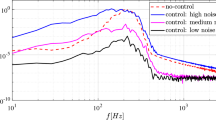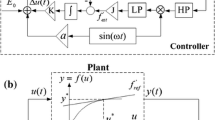Abstract
This manuscript demonstrates the first successful application of the delayed-x-LMS (dxLMS) control algorithm for TS-wave cancelation. Active wave cancelation of two-dimensional broadband Tollmien–Schlichting (TS) disturbances is performed with a single DBD plasma actuator. The experiments are conducted in flight on the pressure side of a laminar flow wing glove, mounted on a manned glider. The stability properties of the controller are investigated in detail with experimental flight data, DNS and stability analysis of the boundary layer. Finally, a model-free approach for dxLMS operation is introduced to operate the controller as a ‘black-box’ system, which automatically adjusts the controller settings based on a group speed measurement of the disturbance wave packets. The modified dxLMS controller is operated without a model and is able to adapt to varying conditions that may occur during flight in atmosphere.



























Similar content being viewed by others
References
Bagheri S, Brandt L, Henningson DS (2009) Input-output analysis, model reduction and control of the flat-plate boundary layer. J Fluid Mech 620(1):263–298
Brynjell-Rahkola M (2015) Global stability analysis of three-dimensional boundary-layer flows. Lic. thesis, KTH, Stockholm
Dadfar R, Semeraro O, Hanifi A, Henningson DS (2013) Output feedback control of flow on a flat plate past a leading edge using plasma actuators. AIAA J 51(9):2192–2207
Duchmann A (2012) Boundary-layer stabilization with dielectric barrier discharge plasmas for free-flight application. Ph.D. thesis, TU Darmstadt
Duchmann A, Simon B, Tropea C, Grundmann S (2014) Dielectric barrier discharge plasma actuators for in-flight transition delay. AIAA J 52(2):358–367
Elliott S, Nelson P (1993) Active noise control. Signal Process Mag IEEE 10(4):12–35
Fabbiane N, Simon B, Fischer F, Grundmann S, Bagheri S, Henningson DS (2015) On the role of adaptivity for Robust Laminar-flow control. J Fluid Mech 767:R1
Fischer PF, Lottes JS, Kerkemeier SG (2008) Nek5000 - open source spectral element cfd solver. http://nek5000.mcs.anl.gov
Grundmann S, Tropea C (2008) Active cancellation of artificially introduced Tollmien–Schlichting waves using plasma actuators. Exp Fluid 44(5):795–806
Gad-el Hak M (2000) Flow control: passive, active, and reactive flow management. Cambridge University Press, Cambridge
Hansen C, Snyder S (1996) Active control of noise and vibration. CRC Press, Boca Raton
Joslin R (1998) Aircraft laminar flow control 1. Ann Rev Fluid Mech 30(1):1–29
Juniper MP, Hanifi A, Theofilis V (2014) Modal stability theorylecture notes from the FLOW-NORDITA summer school on advanced instability methods for complex flows, Stockholm, Sweden, 2013. Appl Mech Rev 66(2):024804
Kim HS, Park Y (1998) Delayed-x lms algorithm: an efficient ANC algorithm utilizing robustness of cancellation path model. J Sound Vib 212(5):875–887
Kotsonis M, Giepman R, Hulshoff S, Veldhuis L (2013) Numerical study of the control of Tollmien-Schlichting waves using plasma actuators. AIAA J 51(10):2353–2364
Kotsonis M, Shukla RK, Pröbsting S (2015) Control of natural Tollmien-Schlichting waves using dielectric barrier discharge plasma actuators. Int J Flow Control 7(1–2):37–54
Kriegseis J, Duchmann A, Tropea C, Grundmann S (2013) On the classification of dielectric barrier discharge plasma actuators: a comprehensive performance evaluation study. J Appl Phy 114(5):053,301
Kriegseis J, Schwarz C, Tropea C, Grundmann S (2013) Velocity-information-based force-term estimation of dielectric-barrier discharge plasma actuators. J Phy D Appl Phy 46(5):055,202
Kriegseis J, Simon B, Grundmann S (2016) Towards in- fight applications? A review on dielectric barrier discharge-based boundary-layer control. Appl Mech Rev 68(2)
Kuo SM, Morgan D (1995) Active noise control systems: algorithms and DSP implementations. Wiley, Hoboken
Kurz A, Goldin N, King R, Tropea C, Grundmann S (2013) Hybrid transition control approach for plasma actuators. Exp Fluid 54(11):1–4
Kurz A, Simon B, Tropea C, Grundmann S (2014) Active wave cancelation using plasma actuators in flight. In: 52nd Aerospace Sciences Meeting, AIAA SciTech. American Institute of Aeronautics and Astronautics
Li Y, Gaster M (2006) Active control of boundary-layer instabilities. J Fluid Mech 550:185–206
Liepmann H, Brown G, Nosenchuck D (1982) Control of laminar-instability waves using a new technique. J Fluid Mech 118:187–200
Liepmann H, Nosenchuck D (1982) Active control of laminar-turbulent transition. J Fluid Mech 118:201–204
Milling RW (1981) Tollmien–schlichting wave cancellation. Phy Fluid (1958–1988) 24(5):979–981
Morino L, Kuot CC (1974) Subsonic potential aerodynamics for complex configurations: a general theory. AIAA J 12(2):191–197
Patera AT (1984) A spectral element method for fluid dynamics: laminar flow in a channel expansion. J Comp Phy 54(3):468–488
Peltzer I, Pätzold A, Nitsche W (2009) In-flight experiments for delaying laminar—turbulent transition on a laminar wing glove. Proc Inst Mech Eng Part G J Aerosp Eng 223(6):619–626
Reeh AD (2014) Natural laminar flow airfoil behavior in cruise flight through atmospheric turbulence. Ph.D. thesis, TU Darmstadt
Reeh AD, Tropea C (2015) Behaviour of a natural laminar flow aerofoil in flight through atmospheric turbulence. J Fluid Mech 767:394–429
Saric WS, Reed HL, Kerschen EJ (2002) Boundary-layer receptivity to freestream disturbances. Ann Rev Fluid Mech 34(1):291–319
Semeraro O, Bagheri S, Brandt L, Henningson DS (2013) Transition delay in a boundary layer flow using active control. J Fluid Mech 731(9):288–311
Simon B, Nemitz T, Rohlfing J, Fischer F, Mayer D, Grundmann S (2015) Active flow control of laminar boundary layers for variable flow conditions. Int J Heat Fluid Flow 56:344–354
Simon B, Schnabel P, Grundmann S (2016) IR measurements for quantification of laminar boundary layer stabilization with dbd plasma actuators. In: New results in numerical and experimental fluid mechanics X. Springer
Snyder S, Hansen C (1990) The influence of transducer transfer functions and acoustic time delays on the implementation of the LMS algorithm in active noise control systems. J Sound Vib 141(3):409–424
Sturzebecher D, Nitsche W (2003) Active cancellation of Tollmien–Schlichting instabilities on a wing using multi-channel sensor actuator systems. Int J Heat Fluid Flow 24:572–583
Thomas AS (1983) The control of boundary-layer transition using a wave-superposition principle. J Fluid Mech 137:233–250
Wang JJ, Choi KS, Feng LH, Jukes TN, Whalley RD (2013) Recent developments in dbd plasma flow control. Prog Aerosp Sci 62:52–78
Weismüller (2012) A new approach to aerodynamic performance of aircraft under turbulent atmospheric conditions. Ph.D. Thesis, TU Darmstadt
Acknowledgments
This work was supported by the German research foundation (DFG) under the Grant No.GR3524/4-1. Simulations have been performed at the National Supercomputer Centre (NSC) with computer time granted by the Swedish National Infrastructure for Computing (SNIC). We also wish to thank Jens Rohlfing from Fraunhofer LBF (Darmstadt) for the fruitful discussions. Finally we appreciate the support of our student and flight test pilot Tobias Hofmann.
Author information
Authors and Affiliations
Corresponding author
Rights and permissions
About this article
Cite this article
Simon, B., Fabbiane, N., Nemitz, T. et al. In-flight active wave cancelation with delayed-x-LMS control algorithm in a laminar boundary layer. Exp Fluids 57, 160 (2016). https://doi.org/10.1007/s00348-016-2242-5
Received:
Revised:
Accepted:
Published:
DOI: https://doi.org/10.1007/s00348-016-2242-5




